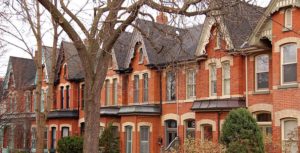The Ontario Heritage Act requires that a standard process be followed by residents proposing to establish an HCD. (The “Ontario Heritage Tool Kit”, A Guide to Heritage Conservation District Designation Under the Ontario Heritage Act, can be found at: www.cabbagetownhcd.ca/HCD_Toolkit.pdf)
Where there has been a proposal for HCD designation initiated by one or more property owners in an area, and where at least a few area residents are in agreement with this proposal, a study of all buildings in the proposed HCD is conducted by a committee of interested area residents. This research (conducted at an archives or library) is intended to identify the age, architectural style and features, historic uses and other details relating to buildings (and even landscapes) in the proposed area. The committee itself will have determined the boundaries of the proposed area.
The committee subsequently hires an architect or heritage consultant (usually partially or wholly funded by the municipality in which the proposed HCD is located) to prepare a draft Heritage Conservation District Plan on behalf of the committee. This Plan, which is drafted based on the research gathered by the committee of area residents, normally includes the following:
- A description (overview) of the historical and architectural character and fabric of buildings and landscapes in the proposed HCD;
- Recommended heritage design guidelines to enable conservation of the heritage fabric and restoration of lost features in both the public and private realm, including:
- Design guidelines that clearly define appropriate change, whether it is for altering existing buildings or for new construction, in the HCD and in areas immediately “adjacent to” the HCD; and
- Design guidelines for streetscapes in order to strengthen their heritage character.
This draft Plan is presented to area residents for feedback at an initial and at least one subsequent public consultation meeting. The feedback from area residents helps to determine what design guidelines will be incorporated in the final draft Plan to be presented to area residents for approval at a final public meeting. Where rejected by a majority or residents present, the proposal to designate an HCD proceeds no further. However, where approved by a majority of residents present, the designation process proceeds through three more steps as follows (assuming the proposed HCD is located Toronto):
- The (now) final Plan is presented to the Toronto Preservation Board that reviews the Plan and makes recommendations for changes (if any) to City Council.
- The final Plan is presented to the appropriate Toronto Community Council, which discusses and votes whether to recommend the Plan to full City Council.
- City Council votes on the recommendation of Community Council. If passed, the area is designated as an HCD by City by-law. If there are no appeals of the HCD designation to the Ontario Municipal Board, the bylaw is enacted. If appealed, the final decision on whether to implement the HCD is made by the Ontario Municipal Board.
It should be noted that to date, the Ontario Municipal Board has never overturned a Council decision on an HCD designation.
Some time after the HCD is designated, the final HCD Plan is printed and distributed to property owners within the proposed HCD for their information. Area residents will be expected to follow the guidelines contained in the Plan in carrying out all future renovations or new construction within the HCD.




